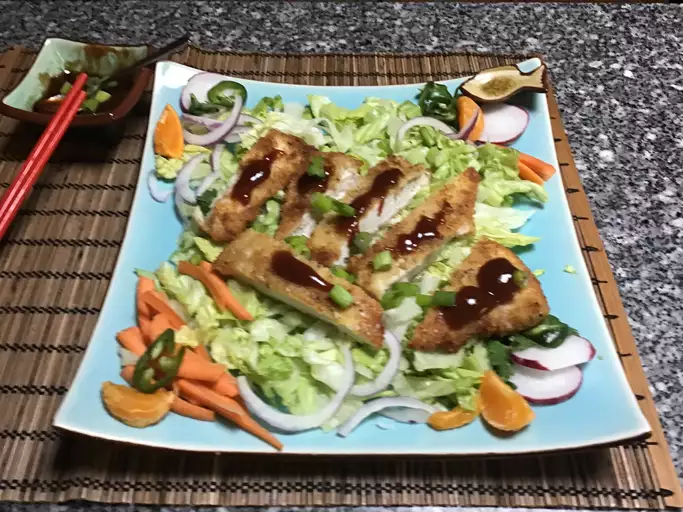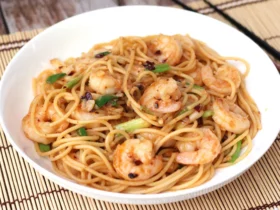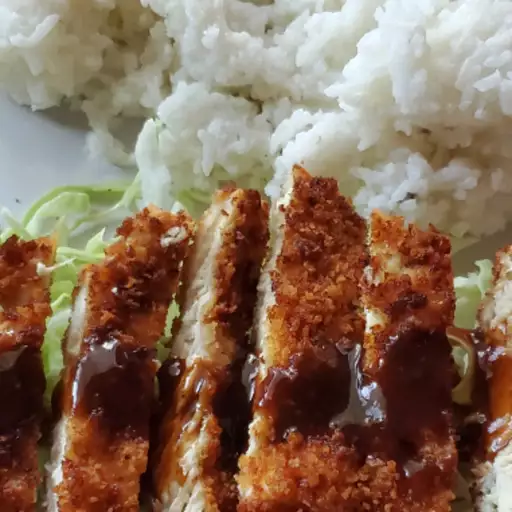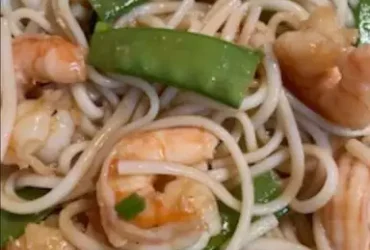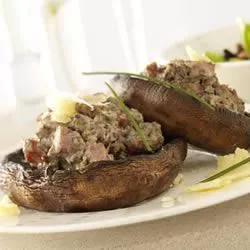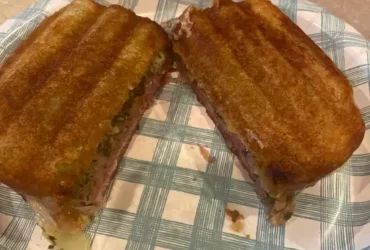Background and History
Chicken Katsu, a beloved dish in Japanese cuisine, is a delightful variation of the traditional Tonkatsu, which is typically made with pork. The word “katsu” is derived from “katsuretsu,” meaning cutlet. Chicken Katsu involves breading and deep-frying chicken cutlets to achieve a crispy exterior while maintaining a tender interior. It is often served with Tonkatsu sauce, a tangy and slightly sweet condiment that complements the savory flavors of the fried chicken. This dish has become a favorite not only in Japan but also in many countries around the world, enjoyed for its comforting and satisfying taste.
Serves
4 people
Time
- Preparation Time: 20 minutes
- Cooking Time: 20 minutes
- Total Time: 40 minutes
Cooking Time
20 minutes
Ingredients
For the Chicken Katsu:
- 4 boneless, skinless chicken breasts
- Salt and pepper to taste
- 1 cup all-purpose flour
- 2 large eggs
- 1 cup panko breadcrumbs
- Vegetable oil (for frying)
For the Tonkatsu Sauce
- 1/2 cup ketchup
- 1/4 cup Worcestershire sauce
- 1/4 cup soy sauce
- 2 tablespoons sugar
- 1 tablespoon Dijon mustard
- 1 tablespoon mirin (optional)
Instructions
Prepare the Chicken
- Pound the chicken breasts to an even thickness using a meat mallet.
- Season both sides with salt and pepper.
Set Up the Breading Station
- Place the flour in a shallow dish.
- Beat the eggs in a second shallow dish.
- Place the panko breadcrumbs in a third shallow dish.
Bread the Chicken
- Dredge each chicken breast in flour, shaking off any excess.
- Dip the floured chicken into the beaten eggs, ensuring it is fully coated.
- Press the chicken into the panko breadcrumbs, covering completely and pressing lightly to adhere.
Fry the Chicken
- Heat about 1/2 inch of vegetable oil in a large skillet over medium-high heat.
- Fry the chicken breasts for about 3-4 minutes on each side, or until golden brown and cooked through.
- Transfer to a paper towel-lined plate to drain any excess oil.
Make the Tonkatsu Sauce
- In a small bowl, whisk together the ketchup, Worcestershire sauce, soy sauce, sugar, Dijon mustard, and mirin (if using).
- Adjust the sauce to taste, adding more sugar or mustard if needed.
Serve
- Slice the chicken katsu into strips.
- Drizzle with Tonkatsu sauce or serve the sauce on the side for dipping.
- Serve with steamed rice and a side of shredded cabbage or mixed greens.
Nutrition Facts (Per Serving)
- Calories: 480
- Protein: 30g
- Carbohydrates: 50g
- Fat: 18g
- Saturated Fat: 3g
- Cholesterol: 135mg
- Sodium: 850mg
- Fiber: 2g
- Sugar: 10g
Notes
- For a lighter version, you can bake the chicken katsu in the oven at 400°F (200°C) for about 20 minutes, flipping halfway through.
- Pounding the chicken ensures even cooking and tenderness.
- Adjust the amount of sauce ingredients to your taste preference.
Allergy Warning
- Contains gluten (flour, panko breadcrumbs, soy sauce).
- Contains eggs.
- Contains soy (soy sauce).
- Contains mustard (Dijon mustard).
- Check all processed ingredients for any additional allergens.
Enjoy your homemade Chicken Katsu with Tonkatsu Sauce, a delightful dish that brings the taste of Japan to your table!
Are katsu and tonkatsu sauce the same?
No, katsu refers to the breaded and fried cutlet, which can be chicken, pork, or another meat. Tonkatsu sauce is a tangy, sweet, and savory condiment typically served with the katsu.
What does tonkatsu sauce go with?
Tonkatsu sauce pairs well with various fried dishes such as chicken katsu, pork tonkatsu, and even as a dip for fries or drizzled over omelets and sandwiches.
What is katsu sauce made of?
Katsu sauce, commonly known as tonkatsu sauce, is made from a blend of ketchup, Worcestershire sauce, soy sauce, sugar, Dijon mustard, and sometimes mirin for added sweetness.
What is tonkatsu sauce supposed to taste like?
Tonkatsu sauce has a balanced flavor profile that is tangy, sweet, and savory, making it a perfect complement to the rich and crispy katsu.
Is tonkatsu sauce healthy?
Tonkatsu sauce can be enjoyed in moderation as part of a balanced diet. It contains sugar and sodium, so it should be used sparingly if you are watching your intake of these ingredients.
What is the purpose of tonkatsu sauce?
The purpose of tonkatsu sauce is to enhance the flavor of fried dishes like katsu by adding a tangy, sweet, and savory taste that complements the crispy and rich fried meat.
Does chicken katsu taste good?
Yes, chicken katsu is delicious, featuring a crispy breaded exterior and tender, juicy interior. It is especially tasty when paired with the flavorful tonkatsu sauce.
Is tonkatsu sauce vegetarian?
Tonkatsu sauce can be vegetarian, but it’s important to check the ingredients on store-bought versions as some may contain animal-derived ingredients like fish sauce. Homemade versions can easily be made vegetarian.
Is katsu spicy?
No, katsu itself is not spicy. It is typically seasoned with just salt and pepper. However, you can add spices to the breading if you prefer a spicier version.
What is a good substitute for tonkatsu sauce?
A good substitute for tonkatsu sauce can be a mixture of ketchup and Worcestershire sauce with a touch of soy sauce and sugar to mimic the sweet and tangy flavors. Alternatively, BBQ sauce can also work in a pinch.
- Best Lusha Alternatives for 2025 - April 22, 2025
- Best Overloop Alternatives for 2025 - April 22, 2025
- Best 6sense Alternatives for 2025 - April 22, 2025

